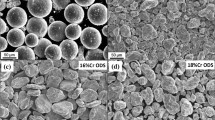Abstract
The sensitivity of thermo-electric power (TEP) measurement to detect the undesired α–α′ phase separation occurring in Cr-rich oxide dispersion strengthened steels was investigated. TEP values were found to increase with time of exposure to 475 °C—the maximum temperature of the miscibility gap in Fe–Cr alloys. Exposure to 650 °C did not induce any changes in the TEP value. By examining the bend contours in dark-field TEM images, α′ precipitates were evidenced in aged PM2000. Using the Fe–XCr–YAl model alloys and X-ray photoelectron spectroscopy, the changes in TEP were traced back to the depletion of Cr from the matrix, caused by the formation of the Cr-rich α′ phase. By quantifying the effect of Cr content on the TEP value of model alloys, it was estimated that following 1000 h of aging, the Cr concentration in the α matrix of PM2000 alloy was reduced from 20 to ~13.5 at.%.




Similar content being viewed by others
References
De Bremaecker A (2012) Phase separation in PM 2000 (TM) Fe-base ODS alloy: experimental study at the atomic level. J Nucl Mater 428(2012):13–30
Verhiest K, Almazouzi A, De Wispelaer N, Petrov R, Claessens S (2009) Development of oxides dispersion strengthened steels for high temperature nuclear reactor applications. J Nucl Mater 385:308–311
Lindau R, Möslang A, Rieth M, Klimiankou M, Materna-Morris E, Alamo A, Tavassoli AF, Cayron C (2005) Present development status of EUROFER and ODS-EUROFER for application in blanket concepts. Fusion Eng Des 75–79:989–996
Dubuisson P, de Carlan Y, Garat V, Blat M (2012) ODS Ferritic/martensitic alloys for Sodium Fast Reactor fuel pin cladding. J Nucl Mater 428:6–12
de Carlan Y, Bechade J-L, Dubuisson P, Seran J-L, Billot P, Bougault A, Cozzika T, Doriot S (2009) CEA developments of new ferritic ODS alloys for nuclear applications. J Nucl Mater 386–388:430–432
Capdevila C, Miller MK, Chao RJ, Russel KF, Chao J, Gonzalez-Carrasco JL (2008) Phase separation in PM 2000 (TM) Fe-base ODS alloy: experimental study at the atomic level. Mat Sci Eng A Struct Mater 490:277–288
Capdevila C, Miller MK, Toda I, Chao J (2010) Influence of the alpha-alpha’ phase separation on the tensile properties of Fe-base ODS PM 2000 alloy. Mat Sci Eng A Struct Mater 490:277–288
Kobayashi S, Takasugi T (2010) Mapping of 475 °C embrittlement in ferritic Fe–Cr–Al alloys. Scr Mater 63:1104–1107
Barnard RD (1972) Thermoelectricity in metals and alloys. Taylor & Francis Ltd, London
Raynaud GM, Guyot P (1988) Coherent precipitation effect on thermo-power of Al–Cu alloys. Acta Metal 36:143–147
Tkalcec I, Azcoitia C, Crevoiserat S, Mari D (2004) Tempering effects on a martensitic high carbon steel. Mat Sci Eng A Struct Mater 387:352
Abdala MRWS, de Blas JCG, Barbosa C, Acselrad O (2008) Thermoelectrical power analysis of precipitation in 6013 aluminum alloy. Mater Charact 59:271
Acosta B, Sevini F (2004) Evaluation of irradiation damage effect by applying electric properties based techniques. Nucl Eng Des 229:165–173
Niffenegger M, Leber HJ (2009) Monitoring the embrittlement of reactor pressure vessel steels by using the Seebeck coefficient. J Nucl Mater 389:62–67
Niffenegger M, Reichlin K, Kalkhof D (2005) Application of the Seebeck effect for monitoring of neutron embrittlement and low-cycle fatigue in nuclear reactor steel. Nucl Eng Des 235:1777–1788
Kawaguchi Y, Yamanaka S (2004) Applications of thermoelectric power measurement to deterioration diagnosis of nuclear material and its principle. J Nondestruct Eval 23:65
Kawaguchi Y, Yamanaka S (2002) Mechanism of the change in thermoelectric power of cast duplex stainless steel due to aging. J Alloys Compd 336:301–304
Ukai S, Fujiwara M (2002) Perspective of ODS alloys application in nuclear environments. J Nucl Mater 307–311:749–757
Mott NF, Jones H (1958) The theory of the properties of metals and alloys. Dover Publications, New York, pp 305–314
Pollock DD (1985) Thermoelectricity; theory, thermometry, tool, ASTM STP 852, Philadelphia. ASTM, Philadelphia
Kittel C (2004) Introduction to solid state physics, 8th edn. Wiley, Hoboken
Kugler W, Knorr K, Prandl W (1983) Study of X-ray-diffraction in magnetostrictive distortion waves in chromium—amplitude and temperature-dependance. Z Kristallogr 162:151–153
Giles PM, Longenbach MH, Marder AR (1971) High-pressure α↔ε martensitic transforamtion in iron. J Appl Phys 42:4290–4295
Fultz B, Howe J (2013) Transmission electron microscopy and diffractometry of materials, 4th edn. Springer, New York, p 363
Capdevila C, Miller MK, Chao J (2012) Phase separation kinetics in a Fe–Cr–Al alloy. Acta Mater 60:4673–4684
Cahn WJ (1963) Hardening by spinodal decomposition. Acta Metal 11(12):1275–1281
Nordheim L, Gorter CJ (1935) emerkungen über thermokraft und widerstan. Physica 2:383–390
Acknowledgements
The authors would like to thank Dr. Y. Gelbstein for performing the TEP measurements and Mr. O. Omassi for casting the model alloys. This study was supported by a dedicated collaboration agreement between the Israel Atomic Energy Commission and the Joint Research Centre of the European Commission.
Author information
Authors and Affiliations
Corresponding author
Rights and permissions
About this article
Cite this article
Pinkas, M., Foxman, Z., Froumin, N. et al. Sensitivity of thermo-electric power measurements to α–α′ phase separation in Cr-rich oxide dispersion strengthened steels. J Mater Sci 50, 4629–4635 (2015). https://doi.org/10.1007/s10853-015-9014-0
Received:
Accepted:
Published:
Issue Date:
DOI: https://doi.org/10.1007/s10853-015-9014-0




